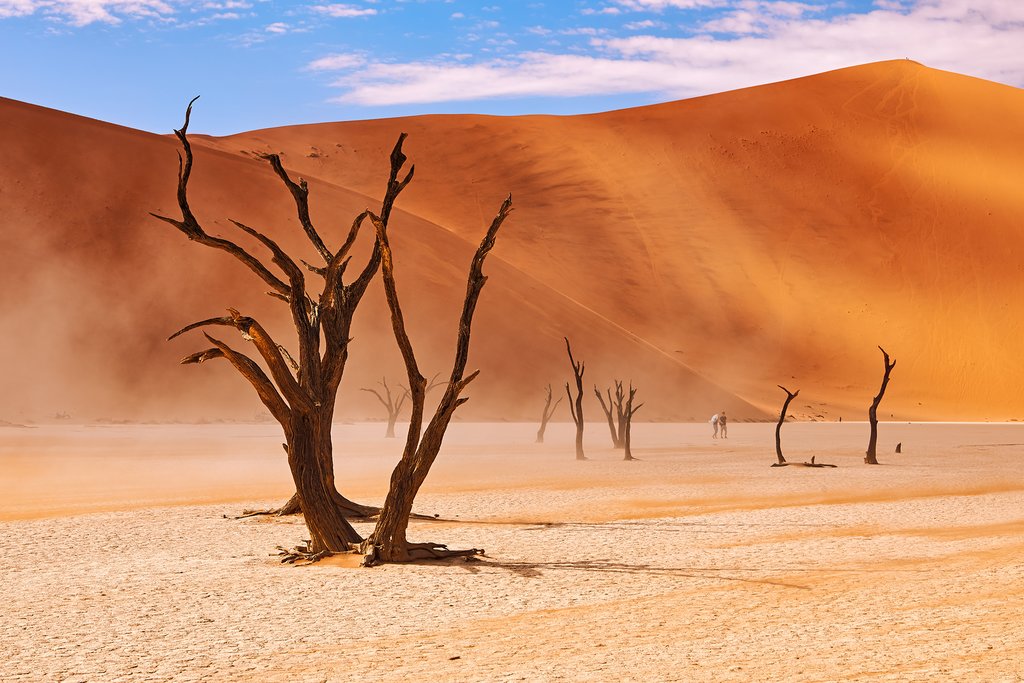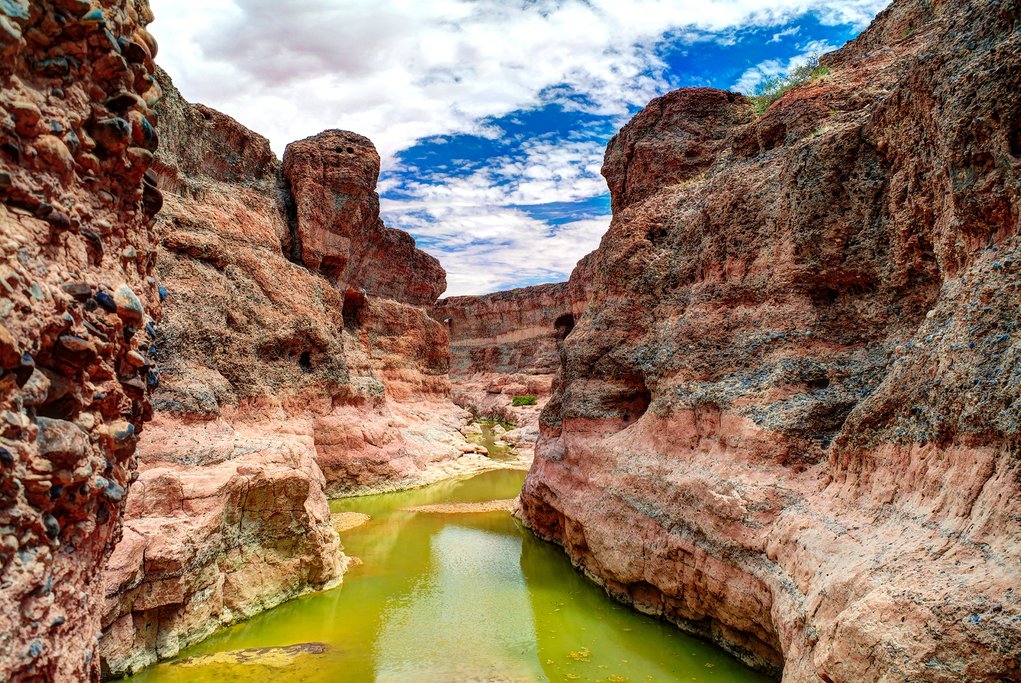Highlights
- Spend time in one of the world's largest and oldest deserts (43 million years)
- Enjoy free time to explore incredible landscapes near Sesriem Canyon
- Relax in two picturesque towns on the Atlantic (one with German history)
- Spend a night at Spitzkoppe, an outdoor paradise known for hiking and climbing
- Pick up authentic African goodies at the Namibia Craft Center
Brief Itinerary
| Day | Highlights | Overnight |
|---|---|---|
| Day 1 | Arrive in Windhoek | Windhoek |
| Day 2 | Drive from Windhoek to the Namib Desert | Sesriem |
| Day 3 | Tour the Sossusvlei Desert | Sesriem |
| Day 4 | Drive from Sesriem to Swakopmund | Swakopmund |
| Day 5 | Explore Swakopmund & Walvis Bay | Swakopmund |
| Day 6 | Drive from Swakopmund to Spitzkoppe | Grootspitzkop |
| Day 7 | Drive from Spitzkoppe to Windhoek | Windhoek |
| Day 8 | Depart Windhoek |
Detailed Itinerary
Day 1: Arrive in Windhoek

Welcome to Namibia! Upon arrival at the Hosea Kutako International Airport, it's time to pick up a rental car and proceed to your hotel in Namibia's capital city, Windhoek—a great base to begin your road trip adventure. This tidy and modern city has a western flair that mixes nicely with urban Africa's colors, sounds, and tempos.
If you have time, learn about the end of apartheid at the Independence Memorial Museum, a free activity with a vast collection of paintings, displays, and artifacts that tell the story of the path to racial freedom. While here, you can visit the National Museum of Namibia, located next door in an old German fort dating back to the 19th century. Take some time to check out fascinating displays about Namibia's Indigenous San rock paintings.
Another great activity in Windhoek is the Namibia Craft Center, a clean and safe covered market with dozens of independent vendors selling the work of thousands of artists around the country. You'll find a range of items from African drums and woodcarvings, as well as elegant Swakara garments and Namibian gemstones. In addition to the stalls, there's also a bookstore, an art gallery, and a popular café that focuses on local ingredients for breakfast and lunch.
You can choose between cuisine options for dinner: Taiwanese, Italian, Portuguese, African, Chinese, French, and German.
Day 2: Drive from Windhoek to the Namib Desert

After breakfast in Windhoek, you'll begin the drive to the Namib Desert (211 mi/340 km), one of the oldest and largest deserts in the world. In fact, the Namib stretches far and wide, covering large swathes of land in Namibia, as well as parts of South Africa and Angola. The distinct arid climate supports a diverse number of plants and animals, some of which are found nowhere else in the world.
Once you reach the desert, you'll be making your way to the Sesriem area, a small settlement close to the southern end of the Naukluft Mountains. You'll drive over the Khomas Hochland highland region along the way as you head west toward the great escarpment. You'll then descend this escarpment via Namibia's highest mountain pass, Spreetshoogte, to enter Sesriem in the central region of Namibia.
Day 3: Tour the Sossusvlei Desert

Today, you'll take part in an early morning excursion that travels along the path of the ancient Tsauchab River into the Namib Sand Sea. The adventure highlights the Sossusvlei Desert, including Dune 45 and Dead Vlei—all surrounded by red dunes in the southern part of the Namib Desert.
In fact, the word Sossusvlei is of Nama descent, which, directly translated, means "a place with many endings." Visitors who come to Namibia often say that this is the most stunning part of the desert, with monumentally high dunes (as high as 1,066 ft/325 m) and the shadows of their sinuous crests that continually change as the daylight waxes and wanes. The warm tints of the sand, ranging from pale apricot to brick orange and deep red, contrast vividly with the dazzling white surfaces of the deflationary clay pans at some of their bases.
In the afternoon, you'll have time to enjoy the landscapes and views around Sesriem Canyon, carved into the Tsauchab River over millions of years, resulting in a narrow gorge of just over a half-mile in length. At the foot of the gorge, which plunges over 100 feet (30 m), are pools that replenish after a good rain. Sesriem derives its name from the time when early pioneers tied six lengths of rawhide thongs ("Ses Rieme") together to draw water from these pools.
Following your excursion, return to your base in Sesriem for the night.
Day 4: Drive from Sesriem to Swakopmund

Today, you'll make the drive to Swakopmund (224 mi), a coastal city facing the Atlantic Ocean.
As you depart the Namib Desert from Sesriem, continue north along the eastern boundary of Namib Naukluft Park. You'll then pass through the small settlement of Solitaire and onward via the Gaub and Kuiseb canyons. Continue across the gravel plains of the Namib Desert toward the country's largest coastal town, Swakopmund. If there's time, you may wish to travel to Swakopmund via the erosional feature of Moon Valley and see Namibia's ancient plant species, called the Welwitschia mirabilis, which is endemic to the Namib Desert.
Once you arrive in Swakopmund, take note of the German architecture. Known for its Old World charm and relaxed atmosphere, Swakopmund was founded in 1892 during the period of Namibia's German colonial rule, when it served as the territory's main harbor.
This is a popular destination for Namibians seeking respite from the heat of the interior of the country. Walk around and check out the town's beaches, walkways, and colonial landmarks, which include the Swakopmund Lighthouse and an old sea wall called the Mole. Next to the lighthouse is the Swakopmund Museum, where you can find documents on Namibian history. Meanwhile, the elegant Swakopmund Railway Station, now a hotel, also dates to the colonial era and is worth a look.
For food and drink, Swakopmund offers a good selection of restaurants and coffee shops that, no surprise, include traditional German fare, cakes, and pastries.
Day 5: Explore Swakopmund & Walvis Bay

Today, you'll have the entire day to explore Swakopmund, and another picturesque coastal town nearby called Walvis Bay at your own pace. Though Walvis Bay doesn't have the same charming German architecture as Swakopmund (thanks to the British), you can find a new waterfront development, great food options, and beautiful dunes that jut up against the Atlantic.
You can also sign up for one of the unique experiences in the area, like the Dolphin Cruise, which sets sail from Walvis Bay Harbour. This is ideal for travelers who'd like to get up close to dolphins, as well as Cape fur seals and flamingo colonies. In addition, there are more desert day-trip excursions to choose from, like quad biking or dune boarding.
Day 6: Drive from Swakopmund to Spitzkoppe

This morning, plan on an early departure from Swakopmund as you make your way to Spitzkoppe (112 mi/180 km). You'll first head northbound through the National West Coast Recreational Area toward the small fishing town of Henties Bay. If you have time, make sure to stop in Cape Cross and say hello to the Cape fur seal colony here (this is also the place where the first European set foot on the coast of Namibia in 1486.)
Leaving the coast, you'll continue toward the region known as Spitzkoppe, called "Matterhorn of Namibia," which consists of a group of bald granite peaks between Usakos and Swakopmund in the Namib Desert. The granite is more than 120 million years old, and the highest outcrop rises about 5669 feet (1,728 m) above sea level. Prepare to be wowed: The peaks stand out dramatically from the flat surrounding plains and beckon outdoor enthusiasts. The highest peak is about 2,200 feet (670 m) above the floor of the desert below, while a minor peak—called the Little Spitzkoppe—lies nearby at an elevation of 5,197 feet (1,584 m).
You'll have the rest of the afternoon to check out the scenery and look for examples of rock art painted in the area. Film buffs will enjoy knowing that the Spitzkoppe Mountains were a location for the filming of "2001: A Space Odyssey."
Day 7: Drive from Spitzkoppe to Windhoek

After breakfast, grab your camera and take advantage of the morning light. This beautiful area is a hikers' and rock climbers' paradise, and the view from the top of the peaks is an incredible reward for the effort to get there. For history buffs, organized guided walks are available where a guide will take you to view some of the numerous rock art sites, explaining the stories captured in the ancient drawings.
When you're ready, make the drive back to Windhoek (174 mi/280 km) for your last night of the trip. If there's time left in the afternoon, feel free to visit any museums, craft stalls, and restaurants that you may have missed at the beginning of your trip. Of course, you can find plenty of options for places to sit back and sip an ice-cold beer.
Day 8: Depart Windhoek

It's time to say goodbye to Namibia! After breakfast at your hotel in Windhoek, depart for the airport with enough time to return your rental car and board your flight home. Safe travels!
More Great Namibia Itineraries
Looking for more inspiration for your trip to Namibia? Check out these other Namibia itineraries, with outdoor adventures, wildlife safaris, and best-of tours to hit the highlights.


